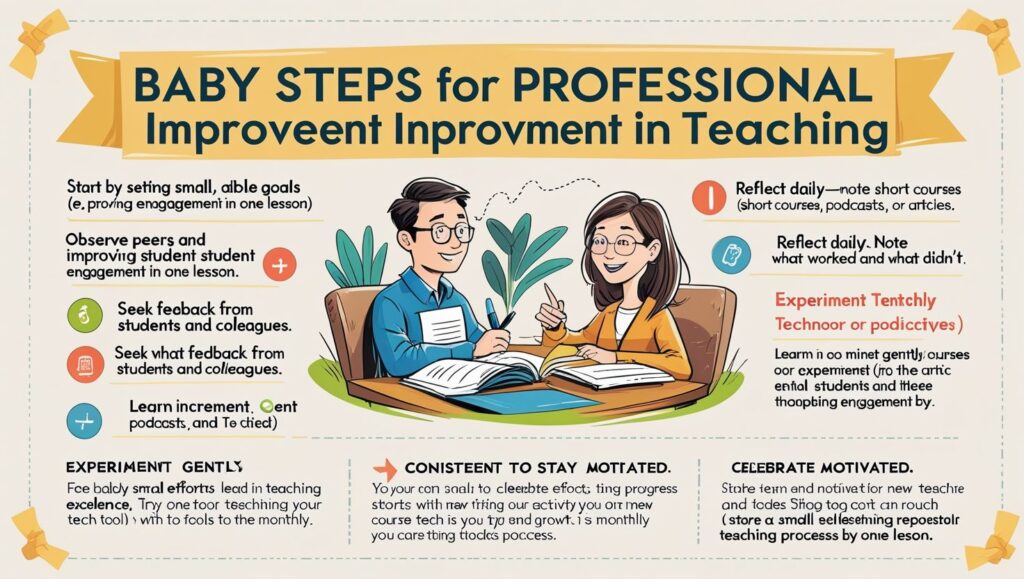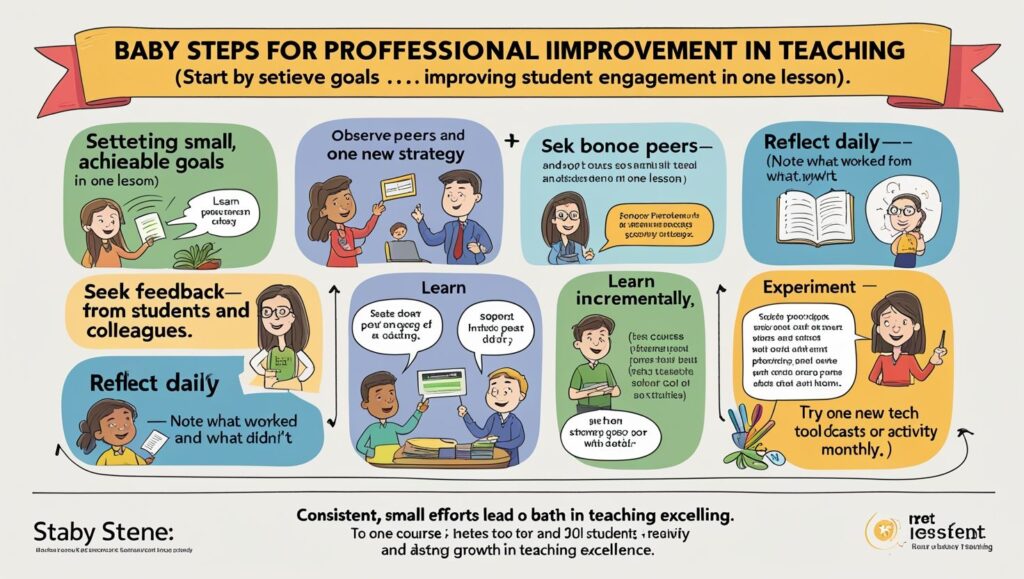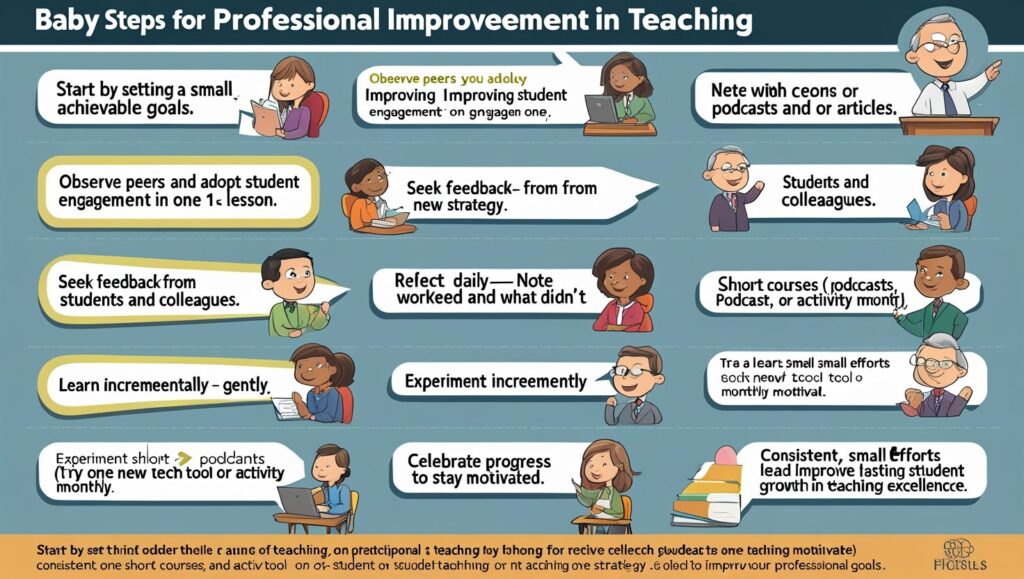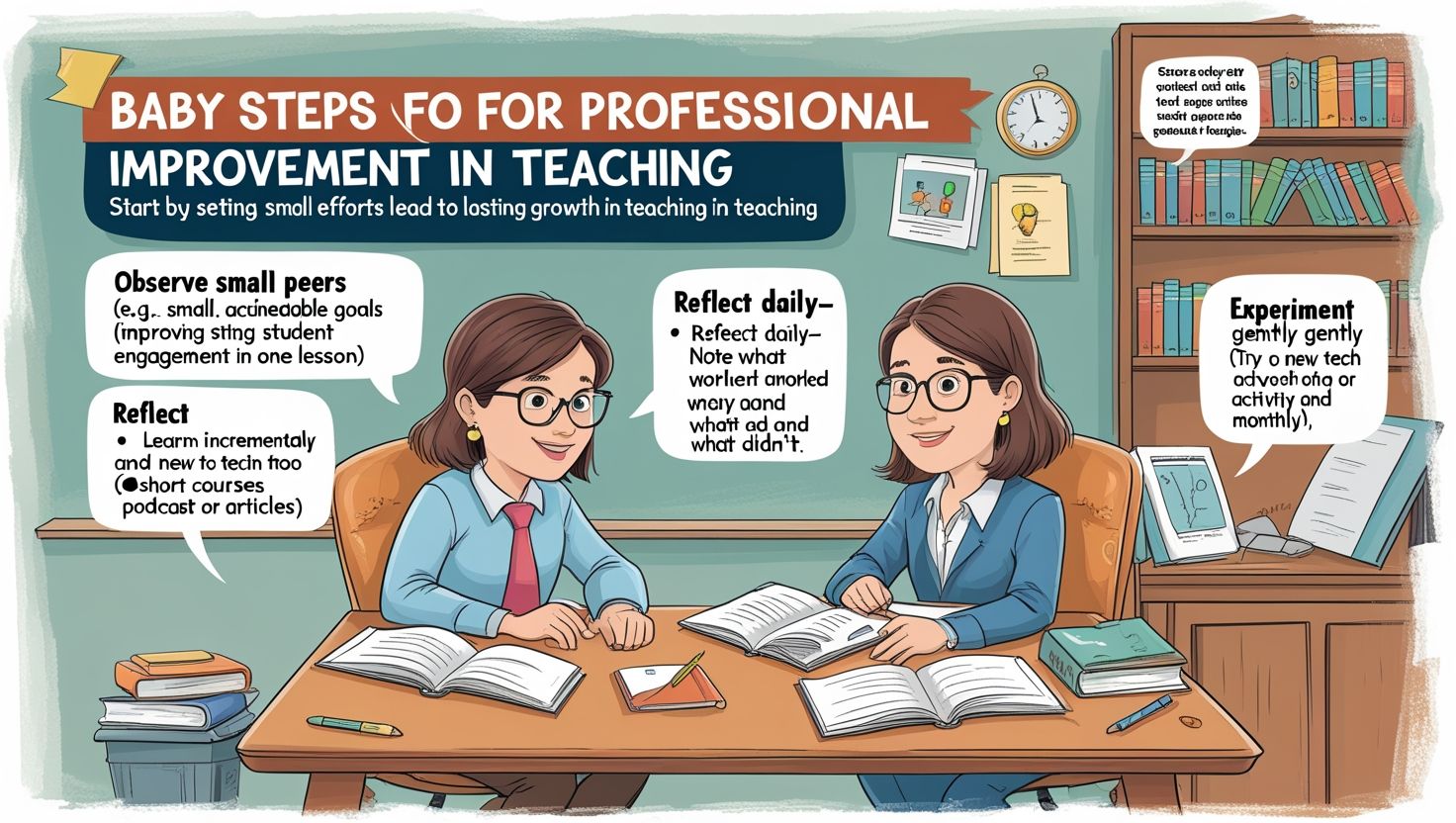Introduction:
Baby Steps for Professional Improvement in Teaching, In today’s rapidly evolving educational landscape, teachers must continuously grow to stay effective. However, professional development does not always require large leaps. Sometimes, it is the small, consistent efforts—often referred to as “baby steps”—that make the most lasting impact. Although the phrase may suggest something minor, in reality, baby steps are deliberate, progressive actions toward professional improvement. They involve setting manageable goals, tracking progress, and reflecting on outcomes. Moreover, these steps are easily achievable within daily routines, making them less intimidating. Importantly, they encourage teachers to focus on consistent betterment rather than perfection.
Furthermore, professional growth is no longer confined to attending formal workshops or earning degrees. It now includes daily reflections, peer learning, integrating technology, and even adapting teaching styles based on student feedback. Indeed, these minor modifications gradually accumulate and significantly enhance a teacher’s capacity to deliver effective instruction. Therefore, this article explores a series of practical baby steps that educators can adopt to enhance their skills and professionalism. Through structured sections, it highlights how regular actions lead to sustainable development. Consequently, teachers are empowered not only to improve themselves but also to uplift student learning outcomes over time.
1. Set Specific Daily or Weekly Goals
First and foremost, teachers should focus on setting small, clear goals that are easy to manage. These can range from improving classroom management to exploring new teaching strategies. For instance, a teacher might aim to integrate one new teaching method in a week. Alternatively, the goal could be to read a short article on educational research every day. These specific objectives help maintain focus and prevent burnout. Unlike broader goals, baby steps provide measurable outcomes that reinforce motivation.
Additionally, these goals act as checkpoints for improvement. Teachers who set them are more likely to reflect on their performance and take corrective actions. Moreover, by meeting these small targets regularly, teachers can build a stronger sense of accomplishment. Importantly, writing down goals and tracking them allows for accountability. In many cases, sharing goals with a peer or mentor can further reinforce this habit.
Besides that, breaking down large tasks into smaller ones reduces procrastination. Instead of planning a complete classroom overhaul, it’s better to implement one change per week. Thus, through consistent goal-setting, educators gradually transform their practices. Step-by-step, these actions lay the foundation for meaningful and lasting professional growth.

2. Reflect Regularly on Teaching Practices
While teaching can be fast-paced, it’s essential to pause and reflect. Reflection enables educators to examine what worked, what didn’t, and why. This practice, when done even for five minutes daily, fosters self-awareness. For example, after each lesson, a teacher can jot down a few lines about student engagement or classroom behavior. These reflections serve as valuable records for identifying strengths and weaknesses.
In addition to personal insight, regular reflection encourages thoughtful planning. When teachers analyze their own teaching, they become more mindful of instructional strategies. Furthermore, reflection supports continuous learning. It allows teachers to consider alternative approaches and experiment with new methods. Equally important, this habit promotes emotional well-being by providing space to release frustration and celebrate success.
Moreover, reflective practice aligns with lifelong learning principles. Teachers who reflect tend to be more adaptable and resilient. They often become proactive in solving classroom challenges. By taking baby steps in reflection, such as writing a brief teaching journal or discussing experiences with a colleague, educators can significantly enhance their effectiveness.
Ultimately, consistent reflection leads to gradual, sustainable professional improvement. Through small yet intentional introspection, teachers nurture their ability to adapt and grow continually.
3. Seek Peer Collaboration and Feedback
Collaboration is a powerful tool for professional development. Teachers often work in isolation, but learning from peers offers fresh perspectives. Therefore, taking the baby step of initiating a short weekly conversation with a colleague can be transformational. Even brief discussions about lesson plans, challenges, or classroom activities can lead to valuable insights.
Additionally, asking for feedback from peers fosters a growth mindset. Rather than fearing criticism, teachers begin to appreciate constructive input. This helps in recognizing blind spots and improving weak areas. For example, a co-teacher may suggest an effective way to handle disruptive students, which the other had not considered. Thus, peer feedback becomes a low-cost yet high-impact professional improvement tool.
Besides that, collaboration encourages shared responsibility. When educators work together, they contribute to a positive school culture. It also promotes team building and trust among staff members. Moreover, observing each other’s classes, even briefly, opens up opportunities for real-time learning.
To start, teachers can join a peer coaching group or form a duo for feedback exchange. These small collaborations can steadily elevate teaching quality. Hence, consistent, open interaction with colleagues is a crucial baby step toward enhanced professionalism.

4. Integrate One New Technology at a Time
In today’s digital era, incorporating technology in the classroom is almost essential. However, trying to learn multiple tools at once can be overwhelming. Therefore, a simple baby step would be to integrate just one new educational technology tool per term. For instance, using Google Forms for quizzes or Padlet for student collaboration can significantly improve engagement.
Furthermore, starting small ensures that the tool is properly understood and effectively applied. As the teacher becomes comfortable, they can explore more advanced features. Besides that, focusing on one tool reduces stress and boosts confidence. It also provides students with a stable learning environment without constant changes.
Importantly, many educational tools come with free tutorials or user communities. Teachers can spend just 10 minutes a day exploring these resources. Additionally, sharing new tech experiences with peers can help others grow as well. Over time, this steady integration of digital tools modernizes the teaching process.
Thus, by adopting one new technology at a time, educators keep up with the digital age without becoming overwhelmed. These manageable steps help improve both teaching delivery and student engagement in a sustainable way.
5. Attend Short Professional Learning Events
Professional learning does not always require long workshops or courses. Sometimes, short webinars or micro-courses offer great value. Hence, a wise baby step is to attend one short learning session every month. These sessions often cover practical topics such as classroom management, inclusive practices, or curriculum design.
Moreover, they are usually available online and can be attended during free time. This flexibility makes them accessible and less burdensome. Additionally, such sessions expose teachers to current educational trends and research. For example, a 30-minute seminar on differentiated instruction can inspire new classroom strategies.
Besides that, these events often come with resources like handouts or toolkits. Teachers can immediately apply these tools in their classrooms. Furthermore, participating in such events shows initiative and commitment to growth. It may also open doors to further professional opportunities.
Importantly, many of these sessions are free or low-cost. Hence, they are a budget-friendly way to stay updated. Over time, attending these micro-learning events becomes a habit that enriches professional practice. Therefore, small but regular learning engagements are key baby steps for long-term improvement.
6. Read Educational Literature Regularly
Reading remains one of the simplest yet most powerful tools for self-improvement. Teachers can start by reading one article or a few pages from a book each week. Although it may seem minimal, this habit significantly expands knowledge. Moreover, educational literature offers insights into pedagogy, psychology, curriculum, and much more.
In addition, reading helps teachers connect theory to practice. For instance, an article on formative assessment might inspire new quiz designs. Also, books often include case studies that mirror real classroom challenges. Teachers can compare those with their own experiences and find relatable solutions.
Furthermore, reading improves critical thinking. It pushes educators to question their assumptions and explore diverse perspectives. Besides that, regular reading builds vocabulary and enhances communication, both of which are vital for effective teaching.
Importantly, literature can be accessed in various formats—print, digital, or audiobooks—depending on individual preferences. Teachers can even form book clubs for shared learning. Therefore, the baby step of reading consistently strengthens professional competence and deepens pedagogical understanding.
7. Practice Active Listening with Students
Often overlooked, listening to students can greatly improve teaching effectiveness. Teachers who actively listen understand student needs, interests, and challenges better. Therefore, a baby step would be to dedicate a few minutes in each class for open dialogue. Students may share feedback, ask questions, or express concerns.
Moreover, this practice builds trust and improves classroom relationships. It helps students feel heard and valued. In turn, they become more engaged and cooperative. Additionally, teachers gain real-time insights into what works and what needs change. For instance, a student might suggest a new seating arrangement that improves group work dynamics.
Besides that, active listening fosters inclusivity. It ensures all voices are acknowledged, including those of quieter students. Furthermore, this habit models respectful communication, encouraging students to listen to each other.
To begin, teachers can ask simple reflective questions like, “What helped you learn today?” or “What was confusing?” These baby steps pave the way for more responsive teaching. Consequently, regular student-teacher dialogue contributes to professional growth through mutual understanding and continuous feedback.

8. Keep a Teaching Journal
Maintaining a journal may seem old-fashioned, yet it remains an effective tool for self-development. A teaching journal helps capture ideas, experiences, challenges, and lessons learned. Teachers can dedicate just five minutes daily or weekly to note reflections or future plans. Over time, these entries become a personal professional archive.
Moreover, journaling promotes deeper reflection. It helps identify patterns, recognize growth areas, and celebrate milestones. For example, writing about a difficult lesson that went well can boost confidence. Conversely, documenting struggles provides an outlet for stress and encourages problem-solving.
Besides that, journals can include lists of student progress, feedback received, or new strategies tried. This organized record is valuable during performance reviews or when applying for professional advancement.
Furthermore, journaling enhances mindfulness. Teachers become more aware of their emotional and mental state, which supports overall well-being. Importantly, digital apps now offer easy, on-the-go journaling options. Thus, this baby step—simple yet powerful—can lead to consistent professional insight and steady improvement.
9. Celebrate Small Successes
Recognizing achievements, no matter how small, builds motivation. Teachers often focus on what needs improvement but overlook their daily victories. Therefore, one important baby step is to celebrate progress. Whether it’s improved student participation or successful use of a new method, every win matters.
Additionally, small celebrations foster a positive mindset. They remind teachers of their impact and reinforce dedication. These celebrations don’t need to be elaborate. A note of self-appreciation, a small treat, or sharing success with a peer is enough. Over time, this habit builds confidence and resilience.
Moreover, celebrating progress teaches students the value of recognizing effort. It models a growth-oriented attitude in the classroom. Besides that, it helps reduce burnout by creating moments of joy amidst routine.
Importantly, acknowledging improvement encourages continuity. Teachers are more likely to repeat successful practices and remain open to new challenges. Thus, by consistently appreciating their efforts, educators nurture their passion and professionalism. Indeed, small celebrations are powerful baby steps toward sustained growth.
Conclusion: Growth Through Gentle Progress
Professional improvement in teaching does not always require monumental changes. More often, it is the steady, small, and thoughtful baby steps that lead to lasting impact. Whether through setting clear goals, embracing feedback, using new tools, or celebrating small wins—each step contributes to a larger journey. Moreover, these small efforts foster a growth mindset and encourage continuous learning. Consequently, teachers not only enhance their own skills but also positively influence student success. In the long run, it is the accumulation of these gentle steps that transforms good teachers into great educators.

Interesting analysis! Seeing platforms like RG777 prioritize data & security (KYC is key!) is reassuring for players. Exploring options like the rg777 app could be a smart move for those wanting a curated experience. Good insights!
Cappadocia pottery Class Mia K. ★★★★★ Pottery workshop with Master Ahmet – he made clay dance! Shipped my creations home safely. Highlight of Turkey! https://www.highpriceddatinguk.com/read-blog/15181
yjyuqo
I dugg some of you post as I cogitated they were very helpful extremely helpful
Some really interesting info , well written and generally user genial.
Great write-up, I¦m normal visitor of one¦s website, maintain up the nice operate, and It’s going to be a regular visitor for a long time.
Loving the information on this website , you have done great job on the blog posts.